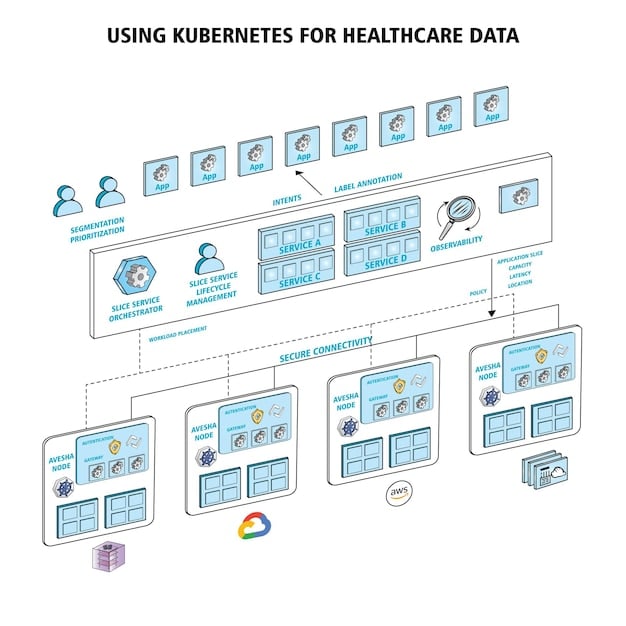Data Privacy Laws are Changing: What Businesses Need to Know to Stay Compliant

Navigating the complex landscape of evolving data privacy laws is crucial for businesses to avoid significant penalties and build consumer trust, requiring proactive strategies for compliance and robust data protection practices.
In an increasingly digital world, the rapid evolution of data privacy regulations presents both challenges and opportunities for businesses. Understanding that data privacy laws are changing: what businesses need to know to stay compliant is no longer optional; it is a fundamental pillar of operational integrity and consumer trust.
The Tectonic Shift in Global Data Privacy
The landscape of data privacy has undergone a seismic transformation over the past decade, driven by technological advancements and heightened public awareness regarding personal information protection. What began as scattered regulations has rapidly coalesced into a complex web of national and international mandates.
Businesses, regardless of their size or sector, are now confronted with a pressing imperative: adapt or face severe repercussions. This isn’t just about avoiding fines; it’s about safeguarding reputation and fostering a trusted relationship with customers. The sheer volume and velocity of data generated today demand a more rigorous and ethical approach to its handling.
From GDPR to CCPA: A Regulatory Cascade
The General Data Protection Regulation (GDPR) of the European Union, enacted in 2018, served as a global catalyst, setting a new benchmark for data protection and privacy. Its broad scope and stringent enforcement mechanisms sent a clear message to businesses worldwide: data privacy is a fundamental right. Following GDPR’s lead, numerous jurisdictions have introduced or significantly updated their own privacy statutes.
- GDPR (EU): Mandates strict conditions for processing personal data, including consent requirements, data breach notifications, and the right to be forgotten.
- CCPA/CPRA (California, US): Grants California consumers extensive rights over their personal information, evolving to include even more stringent provisions with the CPRA.
- LGPD (Brazil): Mirroring GDPR, Brazil’s General Data Protection Law provides a comprehensive framework for personal data processing.
- PIPEDA (Canada): Canada’s Personal Information Protection and Electronic Documents Act is evolving to address more modern data challenges.
Each of these regulations, while sharing common principles, also contains unique nuances that require meticulous attention. A one-size-fits-all approach to compliance is no longer viable; instead, businesses must adopt a granular understanding of the specific obligations imposed by each relevant law.
The Moral and Economic Imperatives of Compliance
Beyond the legal obligations, there exists a profound moral imperative. Consumers are increasingly aware of their data rights and are more discerning about who they trust with their personal information. A breach of trust, whether through negligence or malevolence, can have catastrophic long-term effects on a brand’s viability.
Economically, non-compliance carries substantial risks. Fines for GDPR violations can reach up to 4% of a company’s annual global turnover or €20 million, whichever is higher. Similar penalties exist under CCPA and other regulations. These financial penalties, coupled with the potential for costly litigation and reputational damage, underscore the urgent need for a robust compliance strategy. Investing in data privacy is no longer just a cost center; it’s a critical investment in business resilience and sustainability.
Key Principles Guiding Modern Data Privacy Laws
While the specifics of data privacy laws vary across jurisdictions, a set of core principles typically underpins their design. Understanding these fundamental tenets is crucial for developing a holistic and adaptable compliance framework within any organization.
These principles serve as a compass, guiding businesses toward ethical and legally sound data handling practices, irrespective of where they operate or with whom they interact. Adherence to these pillars not only mitigates legal risks but also fosters a culture of transparency and respect for individual rights, which are increasingly valued by consumers.
Consent and Transparency: The Bedrock of Trust
At the heart of most modern data privacy laws lies the principle of consent. Individuals must be clearly informed about how their data will be collected, used, and stored, and must provide explicit, unambiguous consent. This moves beyond vague terms of service to clear, concise explanations.
- Granular Consent: Users should be able to provide specific consent for different types of data processing (e.g., marketing, analytics).
- Easy Withdrawal: It must be as easy for individuals to withdraw consent as it was to grant it.
- Clear Language: Privacy policies and consent requests should be written in plain, understandable language, avoiding legal jargon.
Transparency extends to data breach notifications, where organizations are often legally mandated to inform affected individuals and regulatory authorities within a short timeframe. This immediate disclosure helps mitigate potential harm and maintains a level of trust even in adverse circumstances.
Data Minimization and Purpose Limitation
The principle of data minimization dictates that businesses should only collect the data that is genuinely necessary for a specified, explicit, and legitimate purpose. This combats the historical tendency to collect as much data as possible, often without a clear rationale.
Related to this is purpose limitation, meaning that personal data collected for one purpose should not be used for another incompatible purpose without further consent. For example, data collected for order fulfillment should not be repurposed for targeted advertising without explicit permission. Implementing these principles requires a thorough audit of current data collection practices and a re-evaluation of data retention policies.

Operationalizing Compliance: A Strategic Business Imperative
Translating theoretical legal requirements into practical, day-to-day business operations requires a strategic and multifaceted approach. Compliance is not a static checkbox exercise; it is an ongoing process that demands continuous vigilance and adaptation.
Businesses must embed privacy by design into their systems and processes, ensuring that data protection is considered from the outset of any new project or product development. This proactive stance is far more effective and less costly than attempting to retrofit compliance after the fact.
Conducting a Thorough Data Audit and Mapping
The first critical step in operationalizing compliance is to understand what data your organization holds, where it resides, and how it flows. This involves a comprehensive data audit and mapping exercise. Without this foundational understanding, it’s impossible to assess risk or implement effective controls.
- Identify Data Categories: Determine what types of personal data are collected (e.g., names, addresses, browsing history).
- Map Data Flows: Document how data is collected, processed, stored, shared, and eventually deleted.
- Assess Data Locations: Pinpoint where data is stored, including third-party cloud services or physical locations.
- Identify Data Owners: Determine who within the organization is responsible for specific datasets.
This mapping helps reveal potential vulnerabilities, identifies areas where data minimization can be applied, and clarifies data retention obligations. It’s an exhaustive process but provides the clear picture needed to build a robust compliance framework.
Implementing Robust Security Measures and Protocols
Data privacy without robust security is meaningless. Laws often mandate that businesses implement appropriate technical and organizational measures to protect personal data from unauthorized access, loss, or destruction. This involves investing in cybersecurity infrastructure, employee training, and incident response planning.
Technical measures include encryption, access controls, pseudonymization, and regular security audits. Organizational measures involve establishing clear policies, conducting regular privacy impact assessments, and training staff on privacy best practices. A well-defined incident response plan is essential for promptly addressing security breaches, mitigating damage, and fulfilling notification obligations.
Revising Vendor Contracts and Partnership Agreements
In today’s interconnected business ecosystem, data often traverses multiple entities. Simply put, your compliance is only as strong as your weakest link, and often that link is a third-party vendor. Businesses must ensure that their vendors and partners, particularly those who process personal data on their behalf, also adhere to stringent data privacy standards.
Revising vendor contracts to include specific data processing agreements (DPAs) that outline responsibilities, security measures, and breach notification procedures is critical. These agreements should specify how data is handled, where it is stored, and what happens in the event of a breach. Regular due diligence and auditing of vendor practices are also advisable to ensure ongoing compliance.
Regional Focus: Navigating US Privacy Statutes
While the ripples of GDPR are felt globally, businesses operating in or serving the United States must contend with a patchwork of state-specific and federal data privacy laws. Unlike the EU’s unified approach, the US regulatory landscape is characterized by its sector-specific and locality-specific nature, adding layers of complexity to compliance efforts.
This fragmented approach necessitates a careful analysis of the states where a business operates or where its customers reside, as each might bring distinct obligations. The absence of a single federal privacy law comparable to GDPR means that companies must synthesize compliance requirements from various sources.
The Expanding Influence of State Laws: CCPA, CPA, VCDPA
California’s Consumer Privacy Act (CCPA), significantly enhanced by the California Privacy Rights Act (CPRA), remains the most influential state-level privacy law in the US. It grants consumers rights similar to GDPR, including the right to know, delete, and opt-out of the sale or sharing of their personal information.
Following California’s lead, other states have enacted their own comprehensive privacy laws, creating a mosaic of regulations:
- Colorado Privacy Act (CPA): Provides consumers with rights to access, delete, and opt-out of targeted advertising and the sale of personal data.
- Virginia Consumer Data Protection Act (VCDPA): Similar in scope to CCPA, it grants consumers rights regarding their personal data and imposes duties on controllers and processors.
- Utah Consumer Privacy Act (UCPA) and Connecticut Data Privacy Act (CTDPA): More recent additions that further expand the landscape, each with its own nuances regarding consumer rights and business obligations.
These laws demonstrate a clear trend toward affording greater control to individuals over their data. Businesses must conduct a thorough impact assessment for each relevant state law to identify discrepancies and ensure comprehensive coverage.
Sector-Specific Regulations and Federal Outlook
Beyond state general privacy laws, businesses in certain sectors must also comply with federal regulations. The Health Insurance Portability and Accountability Act (HIPAA), for instance, governs the privacy and security of health information. The Children’s Online Privacy Protection Act (COPPA) addresses online collection of personal information from children under 13. The Gramm-Leach-Bliley Act (GLBA) protects financial information.
While the prospect of a comprehensive federal privacy law in the US remains a topic of ongoing debate, businesses cannot afford to wait. The current environment demands a proactive, multi-jurisdictional approach, building a flexible privacy program that can adapt to evolving federal or state legislation if and when it emerges.

Building a Robust Data Governance Framework
Effective data privacy compliance is not merely about adhering to a list of rules; it necessitates the establishment of a comprehensive data governance framework. This framework defines the policies, processes, roles, and responsibilities for managing data throughout its lifecycle, ensuring consistent and compliant handling.
A well-structured data governance strategy transforms privacy from a reactive burden into a strategic asset, enabling businesses to leverage data responsibly while minimizing risk. It requires cross-departmental collaboration and a top-down commitment to privacy as a core organizational value.
Appointing a Data Protection Officer (DPO) or Privacy Lead
Many data privacy laws, notably GDPR, mandate the appointment of a Data Protection Officer (DPO) for certain organizations. Even where not legally required, designating a dedicated privacy lead is a best practice. This individual or team serves as the central point of contact for privacy matters, overseeing compliance efforts, advising on data protection impact assessments (DPIAs), and liaising with regulatory authorities.
The DPO or privacy lead should possess deep knowledge of privacy laws, data security practices, and the organization’s data processing activities. Their independent oversight helps ensure that privacy considerations are genuinely integrated into business operations, rather than being an afterthought.
Implementing Privacy-by-Design and Default
The concept of “privacy by design and default” advocates for embedding data protection principles into the very fabric of systems, services, and business practices from the earliest stages of development. It means that privacy considerations are not tacked on as an afterthought but are integral to the design process.
- Proactive, Not Reactive: Anticipate and prevent privacy invasive events before they occur.
- Privacy as the Default Setting: Ensure that personal data is automatically protected in any IT system or business practice, without user intervention.
- End-to-End Security: Protect data throughout its entire lifecycle, from collection to destruction.
- Visibility and Transparency: Keep stakeholders and users informed about data practices.
This approach moves beyond mere compliance, fostering innovation that respects individuals’ privacy and builds consumer trust as a competitive advantage. It requires collaboration between legal, IT, product development, and marketing teams to ensure privacy principles are consistently applied across the organization.
Future-Proofing Your Privacy Strategy
The regulatory landscape for data privacy is dynamic and ever-evolving. What constitutes compliance today may change tomorrow, driven by new technologies, shifts in societal expectations, and emerging legal precedents. Therefore, businesses must adopt a future-proof approach to their privacy strategies.
This involves cultivating a culture of perpetual learning and adaptation, ensuring that the organization remains agile enough to respond effectively to new challenges and opportunities in the realm of data protection. Being proactive, rather than reactive, is key to sustainable compliance.
Staying Abreast of Emerging Technologies and Regulations
The advent of artificial intelligence (AI), machine learning (ML), and the Internet of Things (IoT) presents new frontiers for data collection and processing, often outpacing existing regulatory frameworks. Businesses must understand how these technologies impact personal data and anticipate potential privacy implications.
This means actively monitoring legislative developments, participating in industry forums, and consulting with legal and privacy experts. Subscribing to regulatory updates, attending webinars, and networking with peers can provide invaluable insights into future trends and best practices. A strong privacy strategy is one that can adapt to unforeseen technological and legal shifts.
Fostering a Culture of Privacy Awareness
Ultimately, data privacy is everyone’s responsibility within an organization. Even the most sophisticated technical controls can be undermined by human error or negligence. Therefore, fostering a strong culture of privacy awareness among all employees is paramount.
Regular training programs should be implemented to educate staff on the importance of data privacy, their specific responsibilities, and how to identify and report potential privacy risks or breaches. This ongoing education transforms employees into privacy advocates, reinforcing the organization’s commitment to protecting personal data. A consistent message from leadership about the importance of privacy can significantly influence employee behavior and reinforce a culture of vigilance.
The Competitive Advantage of Privacy Compliance
While often perceived as a burden, robust data privacy compliance offers a significant competitive advantage in the modern marketplace. In an era where data breaches are increasingly common and consumers are more privacy-conscious, businesses that genuinely prioritize data protection stand to gain considerable trust and loyalty.
This proactive stance transforms compliance from a mere cost of doing business into a valuable differentiator, attracting customers and partners who prioritize ethical data handling. It positions a company as a responsible steward of information, strengthening its brand and fostering long-term relationships.
Enhanced Customer Trust and Brand Reputation
In a saturated market, consumer trust is a priceless commodity. When customers know that their personal data is handled responsibly and securely, it builds confidence in your brand. This trust translates into increased loyalty, repeat business, and positive word-of-mouth referrals.
Contrast this with the devastating impact of a data breach or privacy scandal, which can erode years of brand building in an instant. Companies seen as privacy leaders demonstrate integrity and foresight, appealing to a growing segment of consumers who actively seek out ethical businesses. Protecting data is protecting your reputation.
Improved Operational Efficiency and Risk Mitigation
Implementing a comprehensive privacy program often leads to improved data governance and management practices across the organization. This can result in clearer data inventories, streamlined data flows, and more efficient data lifecycle management, reducing fragmentation and redundancies.
Beyond preventing costly fines and legal battles, effective privacy compliance mitigates operational risks associated with data handling. It reduces the likelihood of human error, enhances cybersecurity defenses, and ensures that data assets are managed strategically. This proactive risk mitigation contributes directly to the business’s long-term stability and profitability, allowing resources to be focused on innovation rather than remediation.
| Key Point | Brief Description |
|---|---|
| ⚖️ Regulatory Overview | Global laws like GDPR and US state laws (CCPA, CPA) demand proactive business compliance. |
| 🛡️ Core Principles | Consent, transparency, data minimization, and purpose limitation are fundamental. |
| 📊 Operational Steps | Conduct data audits, implement strong security, and revise vendor contracts. |
| 🚀 Future-Proofing | Stay updated on tech/laws and foster a company-wide privacy culture. |
Frequently Asked Questions on Data Privacy Compliance
The primary impact is the heightened responsibility on businesses to protect personal data, leading to stricter compliance requirements, potential financial penalties for non-compliance, and a significant emphasis on consumer consent and data rights. It necessitates a shift towards privacy-by-design and proactive data governance to maintain trust and operational integrity.
GDPR is a comprehensive framework covering the entire European Union, emphasizing principles like data minimization and the right to be forgotten. US state laws such as CCPA or CPRA are state-specific, often focusing on consumer rights like the right to know and opt-out of data sales, creating a fragmented regulatory landscape compared to GDPR’s unified approach.
Privacy by design means integrating data protection principles into products and processes from the very beginning, rather than as an afterthought. It’s crucial because it ensures privacy is a fundamental component of business operations, minimizes privacy risks proactively, and helps build consumer trust by demonstrating a genuine commitment to data protection standards.
Businesses should regularly conduct data audits, implement robust security measures, revise third-party vendor contracts to include strong data protection clauses, and appoint a dedicated privacy lead or Data Protection Officer. Crucially, fostering a culture of privacy awareness through ongoing employee training is essential for long-term compliance and risk mitigation.
Yes, absolutely. Strong data privacy compliance enhances customer trust and strengthens brand reputation, which are invaluable assets in today’s marketplace. It also leads to improved internal data governance and risk mitigation, reducing the likelihood of costly breaches and legal penalties, ultimately contributing to sustained business growth and profitability.
Conclusion: Navigating the Future of Data Privacy
The continuous evolution of data privacy laws is a fundamental shift that businesses cannot afford to ignore. It is a complex, dynamic landscape requiring ongoing vigilance, proactive strategies, and a deep-seated commitment to ethical data stewardship. By understanding the core principles, operationalizing compliance through diligent data management, and fostering a company-wide culture of privacy awareness, businesses can transform regulatory challenges into significant competitive advantages. Ultimately, prioritizing data privacy is not just about avoiding penalties; it’s about building enduring trust with consumers and securing a resilient future in the digital economy.





